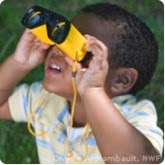Saturday, April 5, 2014
The 3 T's: Every Word You Say Builds Your Child's Brain
Language is exciting! It is the link that connects our thoughts with our actions and our people. Giving our children the love of language is the best gift we can give to them when trying to prepare them for the future. So exactly how do we give the gift of language?
On March 14th and 15th, educators, child advocates, parents, and early childhood specialists from different countries across the state of Colorado gathered at the Rocky Mountain Early Childhood Conference. Saturday's keynote speaker was Dr. Dana Suskind, the Director of the Pediatric Cochlear Implant Program and found of the "Thirty Million Words Initiative" an evidence-based intervention to help all children reach their full listening and spoken language potentials.
The initiative was founded on a world-famous study. Researchers Betty Hart and Todd Risley (1995) found that some children heard thirty million fewer words by their 4th birthdays than others. The children who heard more words were better prepared when they entered school. These same kids, when followed into third grade, had bigger vocabularies, were stronger readers, and got higher test scores. The bottom line: the kids who started out ahead, stayed ahead; the kids who started out behind, stayed behind. This disparity in learning is referred to as the achievement gap. (excerpt from TMW).
The Nest Matters exists to share the latest research that impacts your early learners and wants your child to be better prepared when they enter school. We are sharing only a piece of TMW's curriculum known as "The 3 T's" to motivate you to engage and talk more with your child before their 4th birthday rolls around. Let's start talking!
- Tune In by paying attention to what your child is focused on or communicating with you. The signals your child gives will change rapidly since her attention span is short while she's young - staying tuned in is a dynamic activity.
- Talk More with your child using lots of descriptive words to build his vocabulary. Think of your child's brain like a piggy bank - every word you say is another penny you invest. There is no limit to how many words you can invest to fill your child's band and build his brain! Be as descriptive as possible to build your child's vocabulary.
- Take Turns with your child by engaging in her conversation. Your child is never too young to have a conversation with you! Respond to your child's signals to keep the turns going.
Children in the zero-to-three age group are super absorbent sponges and their development is heavily impacted by their surrounding environments. Here are some things you can do with your child to get the ball rolling.
- Use new and interesting words in natural conversations. Try this at mealtimes or when presenting a new toy. For example, it's easier for your child to learn what a ukulele is when they can see and hear it as well as listening to you say the word.
- Use gestures and facial expressions to help your child make sense of new words. For example, when introducing the word joyful, you might smile and wave your arms about to convey what it means. This can be an opportunity to explain emotions and give words to feelings.
- Sing with your child and recite poetry and rhymes to playfully introduce vocabulary.
- Talk with your child. Keep the conversation going by asking questions, making comments, and inviting your child to think and share their ideas.
- Read to your child daily, taking time to go over new words. Look for books with illustrations that provide clues to word meanings. Let your child read the book to you through their own eyes. Even fi they are not reading every word, let them describe the pictures or create a storyline that can work with the book or moment.
- Think about new vocabulary words that might come up when you are out. A trip to an art exhibit could introduce the word landscape, while a trip to a pizza restaurant might introduce kneeding dough.
- Give your child ample time to learn the meaning and uses of new words before moving onto other words.
NAEYC's Teaching Young Children Magazine has more to say on this very important topic!
Parent talk is the most powerful tool for building your child's brain and sending them to school ready to learn. Language is a game changer for everyone. Learning the 'in's' and 'outs' of one language can inspire and prepare children to learn multiple languages. Take the time to expose your child to language and enjoy the sharing. The effort will pay off!
Learn more about the Thirty Million Words (R) Iniative
The Nest Matters is LOOKING for parents, grandparents, caregivers, teachers, early childhood specialist individuals and groups that would be interested in joining our Interest Group to acquire a Denver Affiliate Status of the National Black Child Development Institute. Please forward your interest to our email address: thenestmatters@gmail.com.
Subscribe to:
Comments (Atom)



